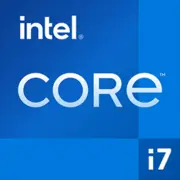Intel Core i7-7700K

Intel Core i7-7700K: Architecture, Compatibility, and Relevance in 2025
An Updated Look at the Legendary Enthusiast CPU
Key Features: Kaby Lake in Detail
The Intel Core i7-7700K, released in 2017, remains an iconic chip for PC enthusiasts. Despite its age, it is still used in budget and niche builds.
Architecture and Process Technology
- Codename: Kaby Lake (7th generation Intel).
- Process Technology: 14 nm (third iteration of Intel’s 14 nm technology, optimized for stability and clock speeds).
- Cores/Threads: 4 cores, 8 threads thanks to Hyper-Threading.
- Frequencies: Base — 4.2 GHz, maximum in Turbo Boost — 4.5 GHz.
- Cache: 8 MB L3, which is modest for 2025 but sufficient for light tasks.
- TDP: 91 W (high for a 4-core CPU, especially when overclocked).
Key Features:
- Unlocked Multiplier — Overclockers still push it to 5 GHz with good cooling.
- Supports Intel Optane Memory — Speeds up HDD performance.
- Integrated Graphics Intel HD Graphics 630 — Suitable for office PCs or systems without a discrete GPU.
Performance:
- Geekbench 6: Single-Core — 1563, Multi-Core — 5093.
- In 2025, these metrics lag behind even budget CPUs like the Core i3-13100F (Single-Core ~2200), but it is adequate for older games and basic tasks.
Compatible Motherboards
Socket and Chipsets
- Socket: LGA 1151 (version v1, not compatible with Coffee Lake 8th generation processors!).
- Chipsets: H110, B250, H270, Z270.
- Z270 — the only chipset with overclocking support.
- B250/H270 — suitable for standard operation.
Considerations in 2025:
- New motherboards for LGA 1151 v1 are no longer produced. Prices on the secondary market range from $50 (B250) to $120 (Z270 in good condition).
- Check BIOS: For operation with the i7-7700K, some H110 boards require a firmware update.
Memory Support
- Type: DDR4-2400 (officially), but many overclock modules to 3000 MHz.
- Maximum Capacity: 64 GB (4 slots × 16 GB).
- Important: DDR5 and newer standards are not supported.
Tip: Use dual-channel kits (2×8 GB or 2×16 GB) for maximum performance. In 2025, DDR4-2400 is considered slow, but it’s acceptable for older systems.
Power Supply Recommendations
- Basic Calculation:
- i7-7700K (91 W) + mid-range graphics card like NVIDIA RTX 3060 (170 W) + other components ≈ 350–400 W.
- Recommended PSU: 500–550 W with 80+ Bronze certification (e.g., Corsair CX550M — $65).
- For overclocking: Choose models from 650 W (Be Quiet! Pure Power 12 M — $90).
Mistakes to Avoid:
- Don’t skimp on the PSU! Older models with low efficiency can cause instability under load.
Pros and Cons of the i7-7700K in 2025
Advantages:
- High single-thread performance — relevant for older games (e.g., CS:GO, GTA V).
- Availability — on the secondary market priced at $80–120.
- Upgrade Ease — if you already have a board for LGA 1151 v1.
Disadvantages:
- 4 cores/8 threads — Multi-threaded tasks (rendering, streaming) are slow.
- Lacks PCIe 4.0/5.0 — Modern SSDs and GPUs won’t unlock the full potential.
- Outdated socket — No upgrade path without replacing the motherboard.
Use Case Scenarios
Gaming:
- 1080p/60 FPS in titles up to 2020 (The Witcher 3, Rainbow Six Siege).
- Limitations: In games emphasizing multi-threading (Cyberpunk 2077), drops to 40 FPS are possible.
Work Tasks:
- Suitable for: Office applications, web development, light video editing (1080p in Premiere Pro).
- Not suitable for: 3D rendering, neural network tasks, 4K editing.
Multimedia:
- Viewing 4K video, streaming (with a discrete GPU), working with photos in Photoshop.
Comparison with Competitors
AMD Ryzen 5 1600 (2017):
- 6 cores/12 threads, but weaker in single-thread tests (Geekbench 6 Single-Core ~1100).
- Price on the secondary market: $60–90. Conclusion: Better for multitasking — Ryzen, better for gaming — i7.
Intel Core i5-13400F (2023):
- 10 cores (6P+4E)/16 threads, Geekbench 6 Multi-Core ~12000.
- New price: $180. Conclusion: i5-13400F is twice as powerful but requires a motherboard change.
Practical Assembly Tips
1. Check Compatibility: Ensure the motherboard supports Kaby Lake (may require BIOS version P2.00 or newer).
2. Cooling: For overclocking, consider a cooler like the DeepCool AK620 ($60) or a 240 mm AIO cooler.
3. Graphics Card: Do not install an RTX 4070 or equivalent — the CPU will bottleneck. Optimal: RTX 3060 or RX 6600.
4. Storage: Choose NVMe SSDs with PCIe 3.0 (e.g., Samsung 970 EVO Plus 1TB — $90).
Final Conclusion: Who Should Consider the i7-7700K in 2025?
This processor is worth considering only in two scenarios:
1. Upgrading an old system: If you already have an LGA 1151 v1 motherboard and DDR4 memory.
2. Budget gaming build: For less demanding games or as a temporary solution.
Not recommended for new PCs — the market offers fresher and more efficient options (AMD Ryzen 5 7600, Intel Core i5-14400F). However, as part of a retro build or for specific tasks, it may still find a place.
Prices are listed for new devices as of April 2025. The i7-7700K is available only in used condition on the market.
Basic
CPU Specifications
Memory Specifications
GPU Specifications
Miscellaneous
Benchmarks
Compared to Other CPU
Share in social media
Or Link To Us
<a href="https://cputronic.com/cpu/intel-core-i7-7700k" target="_blank">Intel Core i7-7700K</a>